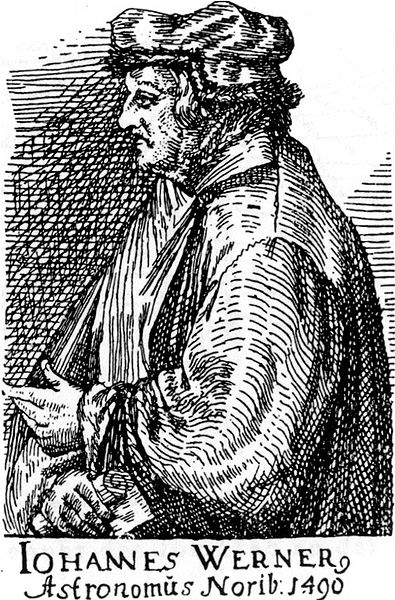<Back to Index>
- Astronomer Johannes Werner, 1468
- Composer Alexander Sergeyevich Dargomyzhsky, 1813
- General Jean Victor Marie Moreau, 1763
PAGE SPONSOR


Johann(es) Werner (14 February 1468 in Nuremberg, Germany – May 1522) (also Ioannis Verneri) was a German parish priest in Nuremberg and a mathematician. His primary work was in astronomy, mathematics, and geography, although he was also considered a skilled instrument maker.
His mathematical works were in the areas of spherical trigonometry, as well as conic sections. He published an original work on conic sections in 1522 and is one of several mathematicians sometimes credited with the invention of prosthaphaeresis, which simplifies tedious computations by the use of trigonometric formulas, sometimes called Werner's formulas.
In 1500 he observed a comet, and kept observations of its movements from June 1 until the 24th. This work further developed the suggestion of Regiomontanus that the occurrences of eclipses and cometary orbits could be used to find longitude, giving a practical approach for this method by means of the cross-staff. (The approach did not actually solve the problem as the instrument was not sufficiently accurate.)
His trepidations method to describe precession of the equinoxes De motu octauæ Sphær was posthumously challenged in 1524 by Nicolaus Copernicus in The Letter against Werner.
He is most noted for his work, In Hoc Opere Haec Continentur Nova Translatio Primi Libri Geographicae Cl Ptolomaei, written in 1514, a translation of the work Geographia (Ptolemy), written by Ptolemy.
He refined and promoted the Werner map projection, a cordiform (heart shape) projection map that had been developed by Johannes Stabius (Stab) of Vienna around 1500.
The crater Werner on the Moon is named after him.
Some of the trigonometric identities used in prosthaphaeresis, an early method for rapid computation of products, were named Werner formulas in honor of Werner's role in development of the algorithm. Since its introduction by Werner in his 1514 book, Nova translatio primi libri geographiaae C. Ptolemaei, the Werner projection was commonly used for world maps and some continental maps through the 16th century and into the 17th century. It was used by Mercator, Oronce Fine, and Ortelius in the late 16th century for maps of Asia and Africa. By the 18th century, it was replaced by the Bonne projection for continental maps. The Werner projection is only used today for instructional purposes and as a novelty. Many consider Werner as a pioneer of modern meteorology and weather forecasting. Between 1513 and 1520, Johann Werner made the first regular observations of the weather conditions in Germany. To determine longitude in navigation, Werner proposed determining time by measuring the position of the moon relative to the background stars. He published this in In hoc opere haec continentur Nova translatio primi libri geographiae Cl' Ptolomaei... (Nürnberg 1514). The method was discussed in detail by Petrus Apianus in his Cosmographicus liber (Landshut 1524). This became known as the lunar distance method.